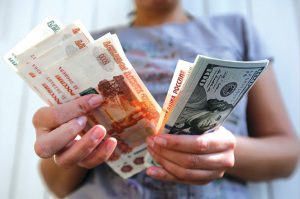BLOOMBERG
The ruble weakened beyond the psychologically important level of 100 to the dollar for the first time since March last year, as Russia’s war in Ukraine drags on and international sanctions throttle the economy. The currency fell 1.5% to 100.975 in its fifth day of losses even after Russia’s central bank sought to arrest the slump by halting its foreign-currency purchases on the domestic market for the rest of 2023. It has weakened 26% this year for the third-worst performance in emerging markets.
Moscow has run a budget deficit for eight successive months as it tries to hold up an economy battered by shrinking export revenues and its isolation from international financial markets. Bank of Russia Governor Elvira Nabiullina has repeatedly cited deterioration in trade as the main reason for the ruble’s weakness. Meanwhile, an aide of President Vladimir Putin seemed to criticise the central bank’s policies for it. “The source of the weakening of the ruble and the acceleration of inflation is soft monetary policy,” Putin’s economic aide Maxim Oreshkin wrote in his column for state agency Tass. Russia needs a strong ruble, and policymakers have the necessary tools to normalise the currency value in the near future, he said.
The central bank announced it would stop buying foreign currency on the domestic market under a budgetary mechanism that was put in place to insulate the economy from swings in commodity prices. The decision aimed to “reduce the volatility of financial markets,” it said.
“The weakening of the ruble is the result of the international screws tightening around the Russian economy, but also the cost of keeping the economy going,” said Erik Meyersson, chief emerging-market strategist at SEB AB in Stockholm. “Nobody wants to hold rubles, and the limited supply of foreign exchange from exporters weighs on the currency. Meanwhile, the current account has been weakening, amid surging imports and lower export revenues, which further adds pressure.”
Revenues of Russian oil and gas exporters declined to $6.9 billion in July from $16.8 billion in the same period last year, according to the latest central bank data. An easing of restrictions on moving money abroad has also led to accelerated capital flight as Russians race to shift funds into foreign accounts.
 The Gulf Time Newspaper One of the finest business newspapers in the UAE brought to you by our professional writers and editors.
The Gulf Time Newspaper One of the finest business newspapers in the UAE brought to you by our professional writers and editors.
